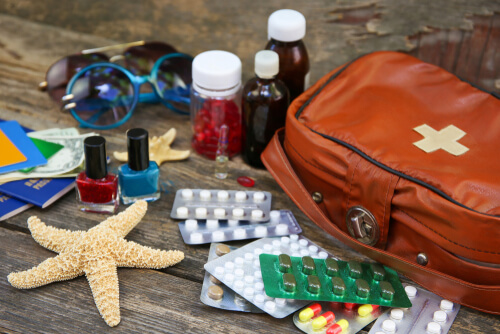We love to travel. According to Visa’s Global Travel Intentions Study 2017, Singapore is the leader in international travel for leisure and business in the Asia Pacific region. We take almost seven international trips over the last two years compared to China (5.8) and Thailand (5.7).
A survey done among 13 000 U.S. international travelers found that 58% of them were taking a daily medication. Currently, there are no figures reported locally.
With greater numbers of older people and those with chronic conditions travelling, carrying medicines while travelling will be increasingly common.

Travelling with medications, even prescription medications, is not as simple as packing it. Here’s how to stay on the right side of the law, wherever you go.
Tips on travelling with prescription medications:
1. Ensure that you travel with medication legally
Each country has its own governing laws about which medicines are legal. There can be serious consequences if you violate the laws of the country you’re visiting. Always check that your medication is allowed in the destination country. You can normally find this information on the country’s embassy, high commission or consulate website or by contacting them. You may need to apply for customs clearance for some medications.
The International Narcotics Control Board provides general information about country regulations for travelers carrying medications that are made with controlled substances. It can serve as a good summary of the regulations imposed in different countries. If your medication is illegal at your destination, ask your doctor about alternatives.
For example it is illegal to bring medications that contain Pseudoephedrine (commonly used as a decongestant in flu medications) into Japan, even when accompanied by a customs declaration and a copy of the prescription.
2. Carry a doctor’s letter and your prescription
The doctor’s letter should state that you are under their treatment and that the medications have been prescribed for your personal use. The doctor’s letter must specify the name, dose and dosage of the medications. Generic names of the active drugs in the medications are preferable as brand names vary from country to country.
3. Keep medications in their original packaging
You should leave your medications in their original packaging, even if you normally use a weekly or monthly pillbox. Security or customs officials may request for proof that you are the patient entitled to the medications.
The original packaging should have a professionally printed label that identifies the medication, or a manufacturer’s name or pharmaceutical label. The original packaging should ideally come with a dispensing label from the pharmacy that provided you with the medication as well. This helps officials identify your medications easily. You can always bring along an empty pillbox with you and organise your medications when you reach your destination.
4. Carry medications in your hand luggage
Always expect the unexpected – illness can strike at any time and luggage can go astray. Always carry your medications in your hand luggage to ensure immediate access when required. It is not necessary to notify the screening officer about your medications you are travelling with unless it is in liquid form.
Medications are exempt from the 100 mL security limit imposed on liquids, aerosols and gels on international flights. However, you must tell the screening officer that you have medically necessary liquids at the start of the screening checkpoint process.
It is also recommended to carry medications in your hand luggage as the temperature in the cabin of the aircraft is more constant. Some medications are affected by temperature and this creates potential problems during travel, especially if refrigeration is required.
In general, airlines are not prepared to take responsibility for storing medications in aircraft refrigerators and, even if they are, there is a risk of the medications getting lost. Gel-based ice packs can stay cold for a long time and may be an alternative option when travelling. Always discuss with your doctor or pharmacist for the best medication storage options before your travels.
5. Carry no more than one month supply
Depending on the length of your travel, you should bring adequate supplies in reasonable quantities only for personal use or for someone you are travelling with such as your child. For countries like Malaysia and Japan, only up to a month supply of medication is allowed. If more than a month’s medication is required, import permissions would normally apply.
Always enquire about the import procedures in your destination country should you need to carry more than a month’s supply of medications.
6. Plan your dosage schedule
If your travel plans take you across one or more time zones, you may need to change the time you take your medications during your trip. Some medications such as insulin will require adjustment of dosing with a change of time zones. Always obtain detailed advice from your doctor and create a dosage schedule together before your trip.




